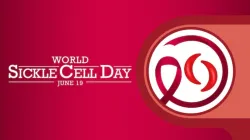Sickle Cell Trait vs Sickle Cell Disease: Differences in symptoms, diagnosis and treatment
World Sickle Cell Day is a crucial step towards breaking the stigma and discrimination associated with this disease, promoting early detection and treatment. Thus, knowing the difference between sickle cell trait and sickle cell disease is also important.

World Sickle Cell Day is an annual global event observed on June 19th to raise awareness about sickle cell disease, a genetic blood disorder that affects millions of people worldwide. This day serves as a reminder to the public and policymakers about the challenges faced by individuals living with sickle cell disease and the need for better healthcare access, treatment, and support. However, it is important to know the difference between sickle cell trait and sickle cell disease.
Difference between sickle cell trait vs sickle cell disease
According to Dr Rahul Bhargava, Principal Director & Chief BMT, Fortis Memorial Research Institute, Gurugram, sickle cell conditions arise from an inherited gene that alters red blood cells. While both sickle cell trait (SCT) and sickle cell disease (SCD) involve this gene, they differ significantly in symptoms, diagnosis, and treatment.
People with SCD experience a distinct struggle. Their sickle-shaped red blood cells obstruct blood flow, causing episodes of excruciating pain (crises). Fatigue, frequent infections, shortness of breath, and stunted growth in children are also common.
In contrast, those with SCT typically face no symptoms and live healthy lives. In rare instances, during extreme exertion, dehydration, or high altitude, they might experience mild pain or blood in the urine.
A simple blood test acts as the key to unlocking both SCT and SCD. In many countries, this test is routinely included in newborn screenings.
There is currently one cure for Sickle Cell Disease, that is Bone Marrow Transplant. However, treatment focuses on managing symptoms and preventing complications. This might involve pain medication during crises, folic acid supplements to promote healthy red blood cell production, antibiotics to ward off infections, blood transfusions in severe cases, and hydroxyurea, a medication that can reduce the frequency of crises.
SCT, on the other hand, doesn't require specific treatment since it doesn't cause symptoms. However, staying hydrated and avoiding strenuous activity at high altitudes can be helpful precautions.
The critical distinction lies in the impact. SCD is a serious, lifelong illness requiring ongoing management. SCT rarely causes problems and doesn't need specific treatment.
People with SCT can still pass the sickle cell gene to their children. If both parents have SCT, their child has a 25% chance of inheriting SCD, highlighting the importance of understanding this difference for informed family planning.
ALSO READ: World Sickle Cell Day 2024: Types, causes, symptoms and treatment of this inherited blood disorder